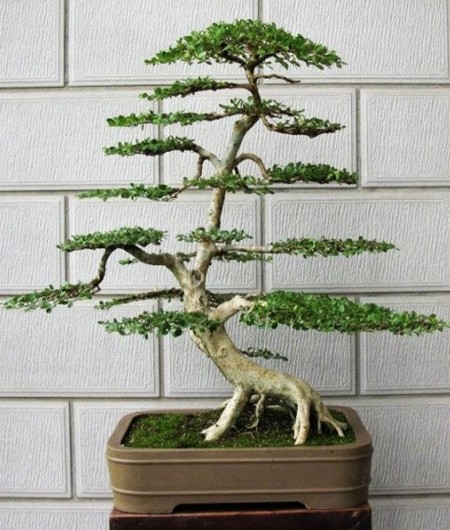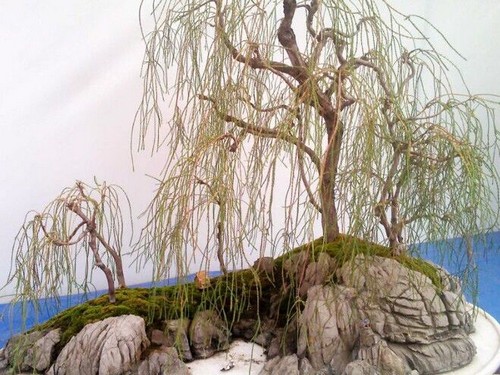The making method of strange willow bonsai
Tamarix branch small leaves, branches drooping, graceful, shaped like weeping willow; its torso such as iron, old and strange, with the quality of pine and cypress; blossom three times a year, the flowering period is longer, the pink flowers are full of branches, more enchanting; its roots, such as swimming dragon, wonderful shape, whether it is root, trunk, leaf or flower, all have incomparable advantages over other tree species, and it is a good tree species for bonsai production.

I. material selection and cultivation measures
Artificial propagation: mainly by cutting, old wood, tender wood can be cut, there are spring and autumn cutting points. Spring insertion is carried out from February to March, selecting more than one-year-old strong branches or stems as cuttings, 15-20 cm long, inserted directly into the seedbed, cuttings exposed 3-5 cm from the soil surface, roots can grow in January-May, and the survival rate is more than 95%. Usually with slightly watering and fertilization management, the seedlings of the same year can be as high as more than 1 meter. Autumn is inserted from September to October, and the sprouting branches of the same year are used as cuttings, the method is the same as spring planting, the survival rate is also very high, and it is very easy to grow seedlings. In addition, it can also be propagated by root division, striping and other methods.
Mountain mining: Tamarix has strong adaptability, and there are common sprouting roots along the hillside and waterside streams. The old piles that have been cut down for many years can be selected to dig back into the basin shape. In a relatively short period of time, the Tamarix bonsai with graceful posture and soft branches can be made.
Second, light and growth
Tamarix likes the environment of strong light and good ventilation. In the process of growth, in addition to using light control method to make branches droop naturally, it should be placed in a place with sufficient light. Due to lack of light and poor ventilation, some larger branches are prone to dead branches in the second year, which will seriously affect the shape of the crown.
Third, trim the shape on the basin
Time: although Tamarix is easy to survive and can be planted in four seasons, it affects the development of root system after night, and the branch itself is malnourished, and it is easy to form the death of individual branches, so it is appropriate to put it on the pot from January to March and from October to December. If you go up or change the basin in the rainy season, you should try to hurt the roots as little as possible and bring more lodging soil.
Selection of basin: Tamarix is generally appropriate to use purple sand pottery basin or glazed pottery basin, the shape of a shallow rectangle or oval is better. If the branches hang, you can put the basin on several shelves, not with a deep tube basin.
Use soil: Tamarix is not strict on soil quality, potted plants had better use fertile, loose pastoral soil or river soil, mixed with the right amount of sand.
Planting: it should be planted in pot before sprouting in spring or after falling leaves in autumn. When planting, you can cut off most of the branches and retain the necessary dry branches to let them germinate and grow to facilitate modeling.
Processing: Tamarix should be processed by the combination of pruning and climbing. Generally, the main branches are properly clambered and cut short, then the overdense ones in the twigs are cut off, and the rest are tied into a drooping type, but it is not suitable to be cut, otherwise the tree shape will be very unnatural. The climbing and binding processing should be carried out before the new shoots are completely lignified, and it is easier to shape. It is better to use brown silk for climbing and binding, and it must be removed to the Beginning of Autumn to avoid "trapping". If the new shoot grows for the second time, it can be climbed again in August to make the new shoot grow in the direction.
Tree shape: Tamarix is suitable for modeling by imitating the posture of willows in nature. The trunk can generally be made into oblique dry type, double dry type, jungle type, curved dry type, horizontal dry type and cliff type and so on. It is better for the branches to be in the form of drooping branches, but not all of them should droop. The main coarse branches should be raised and all the other twigs should droop. In this way, the shape of the tree has bone strength instead of bending over and drooping. It can also be made into a downwind style, with branches fluttering to one side, with the painting meaning of "shore willow wind".
Generally speaking, the weeping branch shape of Tamarix is more common in modeling and pruning, and the difficulty lies in the production of weeping branches when making natural weeping branch modeling. Because, Tamarix is the easiest to grow upward under the condition of growing in nature. Branchlets and side branches are most likely to droop, so when making hanging branch bonsai modeling, the branches can not be allowed to grow freely, but the position, number, density, length, thickness, hierarchical change and overall outline of the drooping branches should be determined according to the requirements of the layout. If the methods of "early branch fixing", "shading treatment", "pulling branches" and "thinning side branches" can be correctly applied, good results can be obtained.
The main results are as follows: 1. Early branch setting refers to the new branch of Tamarix in early spring. When it reaches 10ml / 15cm, it is necessary to set the branch. First of all, the weaker side branches and the lower branchlets should be defined as the branches of the drooping branches. These branches droop most easily and are slender and soft. For strong branches should be erased, because their strong branches are not easy to droop and have no tenderness. If there are few new branches on a local branch, the new branches can be topped to promote the growth of lateral branches.
2. Shading treatment refers to the growing period of Tamarix, the branches are easy to grow upward under strong light, it is better to shade properly and semi-shade is better. Shading for a period of time, most of the branches can naturally droop and soft.
3. Pulling a branch means that when a branch is not easy to sag or the sagging angle is not good, it can be entangled with wire to make it meet the production requirements.
4. "dredging side branches" means that when side branches grow too much or drooping branches are choked, pruning should be done. For the crisscross of random branches should also be adjusted smoothly.
Tamarix in other bonsai modeling, generally with branches Lignification or semi-Lignification, so that it has more natural growth stages. Try to avoid after rain or in the morning, when the branches are brittle and easy to break. When doing pine and cypress styling, it is not easy to trim too many times except that it must be trimmed before the exhibition.
Time: 2019-05-26 Click:
- Prev

Production Technology of Bonsai of Populus tomentosa
Euonymus tomentosa is an evergreen shrub or small tree of Euphorbiaceae. The trunk is gray and smooth, with dense branches and four-angled branches. Leaves opposite, leathery, entire, elliptic or Obovate, apex rounded or retuse, surface bright green, abaxially yellowish green. Flowers clustered in leaf axils or branch ends, blooming from April to May, flowers yellowish green
- Next

Making weeping willow bonsai with strange willow
Tamarix, a Guanyin willow, a Xihe willow. The stem is not very big, the red stem is weak, and the leaves are as thin as strands, graceful and lovely. Make flowers three times a year, the spike is two or three inches long, its color is pink and shaped like a polygonum flower, so it is also known as Sanchun willow. Its flowers bloom immediately when it rains, and should be planted by the waterside ponds. If the sky is going to rain, Tamarix will rise first to respond to it, also known as the Rain Master.
Related
- Fuxing push coffee new agricultural production and marketing class: lack of small-scale processing plants
- Jujube rice field leisure farm deep ploughing Yilan for five years to create a space for organic food and play
- Nongyu Farm-A trial of organic papaya for brave women with advanced technology
- Four points for attention in the prevention and control of diseases and insect pests of edible fungi
- How to add nutrient solution to Edible Fungi
- Is there any good way to control edible fungus mites?
- Open Inoculation Technology of Edible Fungi
- Is there any clever way to use fertilizer for edible fungus in winter?
- What agents are used to kill the pathogens of edible fungi in the mushroom shed?
- Rapid drying of Edible Fungi

